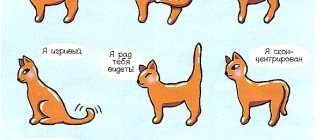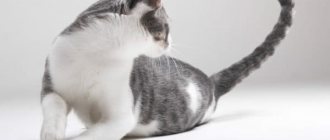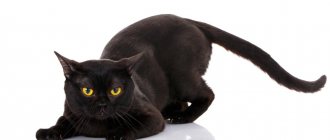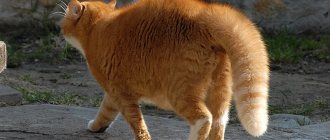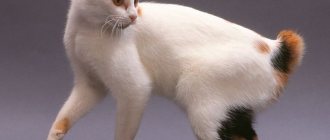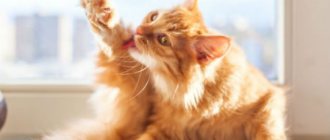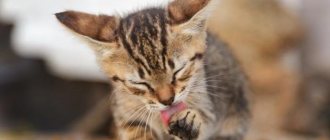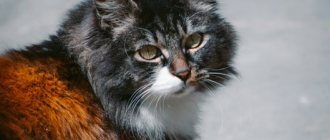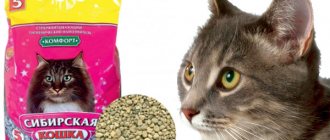Everyone knows that the tail
- This is not only a decoration for a cat. It helps to successfully land on the ground or floor when jumping from a height, to balance fearlessly on fences and tree branches, coordinating the balance of the animal. And the tail of mustachioed pets is a real mood indicator. Unable to express their emotions through words, our smaller brothers use body language. And, perhaps, the movements of a cat’s tail can demonstrate to the owner what the animal is experiencing, more eloquently than any meow.
What is a tail?
Once upon a time, all mammals had tails. But in the process of evolution, those of them who no longer needed this part of the body got rid of it. But cats need it for many reasons, so even today these animals can boast of long, flexible and strong tails.
The tail in cats is an extension of the spine
At its core, a cat's tail is an extension of the spine. It is attached to its main “dorsal” part with the help of a large vertebra. Each one following it decreases in size. Therefore, the tail of most cats resembles a whip, wide at the base and tapering towards the tip.
The vertebrae are fixed quite loosely, cavities form between them. They are filled with a special liquid, which also acts as a kind of lubricant. This allows the tail to move, wag and flex freely.
Cat skeleton
The length of the tail varies depending on the breed, body size and gender. On average, in cats it reaches 28 cm, in cats - 25. The owner of the longest is even listed in the Guinness Book of Records. The length of his pride piece is 44.66 cm.
This is the cat Cygnus. He has the longest tail in the world
To please the owner
There is an unlikely chance that your pet may be chasing its tail in circles to get its owner's attention. Perhaps a kitten once practiced catching imaginary prey
The owner saw this and rewarded him with attention, delicious food, and praise. The kitten remembered this moment and continues to perform the same actions even when it has matured.
shutterstock
The owner should not encourage such behavior. In excitement, a pet can injure itself. When you see a running kitten, it is better not to grab the camera to film what is happening, but to show it to the veterinarian. A funny sight may hide a serious problem.
Why do cats wag their tail?
Deprived of the ability to express their emotions and thoughts verbally, that is, through speech, many animals have developed their own sign language. Cats are no exception. By changing their body position, they can show their attitude towards others, warn about something, declare war or provide a friendly welcome.
By changing their body position, cats show their attitude towards others.
Interesting! A cat's tongue, like any other, can develop. Scientists have proven that some gestures appeared in their “vocabulary” during the process of domestication. For example, only domestic animals can “hug” their owner’s leg with their tail, expressing their affection. Their wild relatives will not understand such a gesture.
However, tail wagging does not always mean that animals are trying to say something. So, if the air temperature is too high, they can use it as a kind of fan. In this case, unhurried, as if lazy movements of the tail will only mean that the animal is hot.
During the hot season, cats use their tail as a kind of fan.
A cat can activate its fifth limb in preparation for a jump. She needs this for proper balancing. The tail in this case plays the role of a rudder.
Also, some movements can signal poor health. Careful observation of your pet’s behavior will help you identify this or that disease in time and prevent it from developing.
What can a cat's tail tell you?
Cat peeing with blood after spinal injury
My cat is 1 year old, two days ago, trying to get outside, she got stuck in the window opening in the pelvic area, the window was open in a vertical position, i.e. the hind legs were in the apartment, and the body was on the street. The cat stayed in this position for 0.5 to 1.5 hours, after which her hind legs became paralyzed, but she tried to move on her front legs, and even went to the toilet in a small potty. An x-ray showed that there were no fractures, the veterinarian made a conclusion - a rupture of the spine. Prescribed: Actovegin, Gamavit, Travmatin. On the second day, the cat began to pee with blood, the doctor said that the kidneys were damaged. The cat mostly sleeps, responds to its name when you pet it, purrs, rolls over from side to side, tries to sit, moves its hind legs, wags its tail when I touch it. lumbar area, eats only liquid food in small quantities, and has basically not walked since the incident. What to do in this situation, what to do with blood in the urine, how to raise the cat to its feet? Help me please. In advance, thanks.
I can’t say anything about the diagnosis, as it confuses me somewhat: since there is mobility and there is hope that the spine is still intact. It is important to limit the cat’s movements for several days: lock it in a small enclosure, for example. Kidney support is definitely needed. Is it possible to take a urine test and take the pictures to another veterinarian?
There is an opportunity to go to another vet, but only on the trail. week, because need to go to the neighbor. city, maybe on Mon. I'm afraid she might get worse. The cat tries to get up, but cannot raise its pelvis and straighten its legs at the knees, which is why it turns out to move as if on its knees... How to support the kidneys? Vet. Today he told me to give him a nettle decoction, and on top of that he prescribed amoxilin subcutaneously and Erwin the cat (drops). What can you say, whether this treatment, in your opinion, corresponds to the one described with
Source
How to determine your pet's mood by its tail
The communicative function is one of the main ones for the tail. By waving it, the animal can demonstrate a whole range of emotions, from hatred to all-consuming love. Everything matters: the direction of movements, their amplitude and speed.
What does the position of a cat's tail indicate?
A complete dictionary of the “tailed” language could look like this:
| Gesture | Image | Explanation |
| The tail is raised sharply and “quivers” slightly | “I love you”, “I’m very glad to see you” | |
| The tail is raised and sways slightly | "Let's play" | |
| The tail lies on the floor and twitches slightly | “Something interesting”, “I’m interested” | |
| The tail moves quickly and sharply horizontally | “I don’t like this at all, I’m angry” | |
| Only the tip of the tail moves | “I am completely happy, calm and satisfied with life” | |
| The tail moves relaxed and calmly along a large trajectory | “I’m all lost in thought,” “What should I do now?” | |
| The tail moves quickly horizontally | “I’m extremely unhappy”, “You’re annoying me”, “Leave me alone” | |
| The tail beats the floor desperately | “I’m shocked”, “I’m stressed” | |
| Tail movements become faster | “Don’t come close to me”, “Now I’ll attack you” | |
| The tail is lowered and hangs loosely | “I’m happy with everything, but I’m determined to communicate” | |
| The tail is fluffed, raised up, motionless or slightly quivering | “I’m very angry”, “Everyone run away from me”, “Careful! Now I will kill" | |
| Tail up | “I’m in charge here and I feel good” | |
| The tail is raised and arched | “I sense danger and am ready to defend myself” | |
| Tail tucked | "I feel very bad" |
Interesting! Cats can also move their tail in their sleep. There is no need to be afraid of this. This only means that the pet is currently having a dream and is acting in accordance with its plot.
Interesting fact about the relationship between cats and people
Other emotions
The tail will also tell you about other features of the cat’s mood. Let's look at what else his movements indicate.
A thoughtful wagging of the tip of the tail - something attracted the cat's attention. She listens, sniffs, looking for an object that interests her, and moves her tail to the beat of her “reflections.”
At such moments it becomes like a question mark. Calm wiggles while playing with the owner demonstrate her good disposition and pleasure from having fun together. However, during gameplay the cat may begin to cross the boundaries of permitted behavior. This will be noticeable by the accelerating movements of the tail, which may be followed by painful bites and scratches on the person. Cats wag their tails vertically when they are either sexually aroused or want to play. When a cat, instead of waving its tail, taps it on the floor with small nervous movements, this means that it is not just nervous, but is experiencing stress. Also, tapping often indicates that your pet is in pain. Having noticed that the cat began to wag its tail in this way, the owner needs to be alert and provide assistance to the animal.
Some owners notice that the cat constantly wags its tail when dozing. Smooth, gradually subsiding movements indicate that the animal is comfortable, it feels safe and is gradually going to sleep. Having fallen soundly asleep, cats sometimes also begin to twitch their tail. Scientists believe that they dream and react to them in a similar way. Having noticed such body movements in a sleeping pet, the owner need not worry - his pet is simply “chasing” another mouse in his sleep.
How else can a cat “talk”?
The tail is not the only way a cat can show its attitude. Animals have quite a lot of visual aids: ears, paws, and the whole body. Quite often they convey information using sound signals.
Interesting! Tailless cat breeds are becoming increasingly popular. Now there are several dozen of them. Some are already recognized as felinologists, others are just winning their hearts. The owners of such pets claim that the absence of a fifth limb does not interfere with their mutual understanding.
Tailless cat breeds
The human-cat dictionary can be supplemented with the following sections.
Communication using the body
Cat conversations can involve the whole body. With the help of movements, the animal is able to convey all important information and clarify details “left unsaid” by the tail.
| Gesture | Image | Designation |
| Ears raised up and tense | “I’m interested”, “I’m listening to you” | |
| Mustache pointing forward | “I am completely happy, calm and content” | |
| Mustache points backwards | “There’s danger somewhere nearby, but I’m on my guard.” | |
| Head down | “I acknowledge your superiority”, “I’m bored” | |
| Fingering with paws | “I love you”, “I want to please you” | |
| Rubbing on feet | “You are only mine”, “Stroke me” | |
| Somersault, belly up pose | “I trust you completely”, “I love you” | |
| Trying to touch a person's face with a paw | “I need your attention”, “Stroke me” | |
| Half-bent stance | “I feel danger, but I want to avoid a fight”; “Let’s resolve everything peacefully or I can’t vouch for myself” | |
| Arched back | "I will fight" |
Communication using glances
Eyes also play a huge role in dialogue. By studying the cat's language of views, you can not only learn to understand your pet, but also respond to him in such a way that he understands.
Do you want to tell your pet that you love him? Then squint a little and look closely into his eyes, and then slowly blink a few times
- bulging eyes, unblinking gaze - “I am the strongest here, go away”, “Fear me”;
- squinting, blinking - “I like you”, “I feel calm and comfortable.”
Advice! If you want to convey to your pet that you love him and will never hurt him, squint a little and look carefully into his eyes. And then blink slowly a few times.
What does the position of a cat's ears indicate?
Communication using sounds
Scientists estimate that cats can make about 30 different sounds. Each has its own meaning. Sometimes it is difficult for a person to distinguish one from the other. The owner’s ear may not be able to detect the change in timbre and volume. But there is a rule that will help determine the mood of the pet giving the sign. The lower his “meow” sounds, the more negative emotions he experiences.
The basic sounds that cats make can be translated into human language as follows:
- the usual even meow - “I need attention”, “Show me how you love me”;
- loud insistent meowing - “Give me something to eat”, “Pour me some water”, “Open the door for me”;
- deep guttural growl - “I’m very angry”, “Everyone disperse!”;
- hissing - “I’m scared, but I will defend myself to the last”, “Now I’ll give you a beating”;
- purring - “I feel very good”, “Keep doing what you are doing”;
- squeal - “It hurts!”
How to determine a cat's mood
Interesting! Some scientists suggest that cats make sounds only for humans, and their communication with their relatives can take place in complete silence. However, there are also opponents to this theory. Their main arguments are the voices that newborn kittens make and the “concerts” that adults throw only for “their own.”
Video - How to find a common language with a cat
Communication using language.
If a cat is scolded, then it begins to lick itself without ceasing, while its ears are pulled back, its eyes are half-closed - this means confusion and the best time for communication.
If the owner is in a good mood, the cat will lick you with love - this is a manifestation of affection.
The cat licks you, looking for an opportunity to climb onto your lap. Short, jerky licks while the cat is looking at you is a search for mercy.
The cat licks itself with deep, intense movements. If she is licking herself for obviously longer than necessary, pet her or play with her - this is a sign of boredom.
The cat licks itself with short, nervous strokes - it needs affection and play, a convenient time for communication.
Cat
washes carefully, rationally - a good time to practice several commands.
If two cats are fighting or are about to fight and suddenly one of them begins to lick itself, this is a sign on its part for a truce.
The meaning of body movements
The cat is a graceful creature with developed muscles and amazing flexibility. It is easy for her to give her body any desired position and make a variety of movements. The ability to recognize these signs helps you understand exactly what your pet wants to tell you and what emotions he is experiencing. A cat can:
- to mark time;
- rub against legs;
- lie on your back, opening your stomach;
- bend and straighten paws;
- arch your back;
- curl up into a ball.
Quite often, cat owners notice how she begins to move her front paws, mark time, as if she is “kneading dough.” This movement indicates that the pet feels pleasant emotions and is comfortable. This habit has remained from an early age, when the kitten kneads its mother’s belly so that milk flows into the nipples. The owner can consider marking time a declaration of love.
Everyone understands that if a cat rubs against its legs, it communicates a feeling of affection and expresses gratitude. But such movements are not only a manifestation of positive emotions. The pet must leave its scent so that all other animals immediately understand that this is its owner.
With this gesture, the cat can ask the owner for food or say that it needs attention and affection.
In the language of animals, lying on your back means submission. If a cat takes this position, opens its tummy, it confesses its love and says that it completely trusts you. The owner may consider such a gesture as an expensive compliment.
A confident, calm, peaceful pet has straightened legs. If a dangerous situation arises, the cat “crouches.” Bent hind and front legs indicate that she does not want to fight, but if necessary, she will provide adequate protection. The animal can sit on its hind legs and stretch out in a column, like a gopher. The cat takes this position when it is overcome by curiosity and must understand what is happening.
It is easy to understand that an arched back is a challenge, a preparation for the upcoming battle. This gesture can be seen before cats fight. At the same time, the animals' ears flatten, their eyes open wide, and the hair on their tail and back stands on end. Cats can also arch their backs during play, thus demonstrating their readiness to attack.
A peaceful, calm pet curls up comfortably into a ball and rests. He is comfortable, he does not feel any danger. A relaxed position on the side with outstretched legs also speaks of calmness.
Learning cat language will help you communicate comfortably with your pet and know everything about its desires and emotions.
Authors of the articles: Belanta Clinic team
Reason #1: tags
Whiskered pets leave their scent marks in order to attract the opposite sex and scare away competitors not only on horizontal surfaces, but also on vertical ones. To do this, they take a characteristic pose:
- maintain a straight body position and do not squat;
- point the tail straight up and spray a small stream of urine in the desired direction.
When marking territory, a slight tremor is explained by muscle tension that occurs involuntarily. Contrary to popular belief, not only males, but also females mark their territories. The only difference is that the latter do this less often, and their smell does not hit the nose so much.
“
In both cases, the situation is corrected by castration, but with one caveat. It does not eliminate the problem forever, but only reduces the likelihood of its occurrence.
Under certain circumstances, even castrati can mark. Most often this is explained by competition with a new pet who has not yet been neutered. The urine of these cats has a stronger odor and gives them a competitive advantage. Because of this, the spirit of rebellion awakens in the “old-timers”, and they again take up the old ways in order to prove their leadership qualities to the “newcomer”.
Reason #6: itching in the lower back
Sometimes owners are puzzled by why the cat twitches and shakes its tail, but does not mark. The simplest explanation for this behavior is severe itching. In both cases, there is indeed a slight contraction of the back, but if your pet has scabies, it is recommended to check for ectoparasites, that is, lice eaters, ticks and fleas.
In addition to itching, the main symptoms of infection include:
- constant scratching;
- hair loss, brittleness and dullness;
- partial or complete loss of appetite;
- the formation of ulcers and scabs at the site of scratched bites;
- moving black spots on the body;
- sleep disturbance;
- apathy or anxiety;
- reduction in body weight.
An animal with these symptoms should be seen by a veterinarian. Otherwise, complications may develop.
Another possible explanation for back contraction is rapid bowel movement. This is normal, but only if the pet goes to the toilet consistently.
Problems with bowel movements, accompanied by restlessness, poor appetite and plaintive meowing, may indicate constipation. The help of a veterinarian is also required here, since prolonged accumulation of feces can lead to intestinal rupture.
In addition to ectoparasites, a cat can be bitten by stinging insects: wasps or bees. The main danger of such bites is the presence of an allergic reaction to saliva. Regardless of the severity of the condition, the bitten pet should be taken to a veterinary clinic to prevent the development of anaphylactic shock. It can be recognized by the following signs:
- blue or pale mucous membranes;
- difficulty breathing;
- rapid increase in swelling;
- the appearance of severe vomiting or foam from the mouth;
- fainting.
A similar condition can be caused not only by wasp or bee saliva, but also by other allergens: pollen, household chemicals, tobacco smoke, and some foods.
When skin reactions occur, allergies can easily be confused with dermatitis, so do not self-medicate and be sure to consult a veterinarian if you have any alarming symptoms.
Reason #2: passion for the hunt
Sharp twitching with swaying in different directions is typical for games with stationary objects and direct hunting of birds and rodents. In this way, the animal prepares for an attack and focuses on its prey.
Before the actual jump, you can see a peculiar wagging of the butt. This is necessary to distribute its own weight and calculate the flight path to the target.
IMPORTANT!
Discourage play with hands and feet. An older kitten can inflict very deep scratches without realizing the danger of its actions.
For homebody cats, chasing toy mice and teasing sticks replaces walks on the street. Thanks to regular active games, you can not only maintain your current weight, but also lose extra pounds. In the absence of contraindications, this method of losing weight is preferable, since reducing the usual portions leads to constant begging, theft, and waking up the owners in the middle of the night due to an acute feeling of hunger.
Estrus
The second stage of the estrous cycle is estrus, or estrus itself, the stage of sexual receptivity. Breeders talk about it as a calling cry to a cat, or a hunt. It can last from one to twenty-one days, with an average duration of 5-7 days. The most favorable days for coverage are the 3rd and 5th days. Although this factor is very individual for each cat (some of them do not ovulate until the 9-10th day). Depending on the cat's temperament (most often determined by its breed), it demonstrates its condition in different ways. One cat becomes “noisy”, constantly meowing loudly; the other, presenting a pitiful sight, lies spread out - suffers in silence, only occasionally “quacking”, evoking universal sympathy with her unhappy appearance.
Cat, March, heat
But both of them become more intrusive and affectionate, rubbing against objects and clearly staring at all male representatives (cat, owner, guest). They roll around on the floor, and if you stroke the lumbosacral region of a cat with your hand, a contraction of the perianal region may occur, the cat falls on its front paws and, as it were, “tramples” with its hind paws, moves its tail to the side and rolls around on the floor. The animal's appetite is reduced or absent. There is frequent urination.
To determine if your cat is ready to be coated, gently hold her and run your hand along her back, from her neck to her tail. If yes, then she will raise her pelvis up, move her tail to the side and begin to stomp on one place with her hind legs. There is also a so-called “erased” estrus, which passes with invisible or muted signs. The same estrus that makes ordinary cat owners very happy and greatly upsets breeders planning to have purebred kittens.
